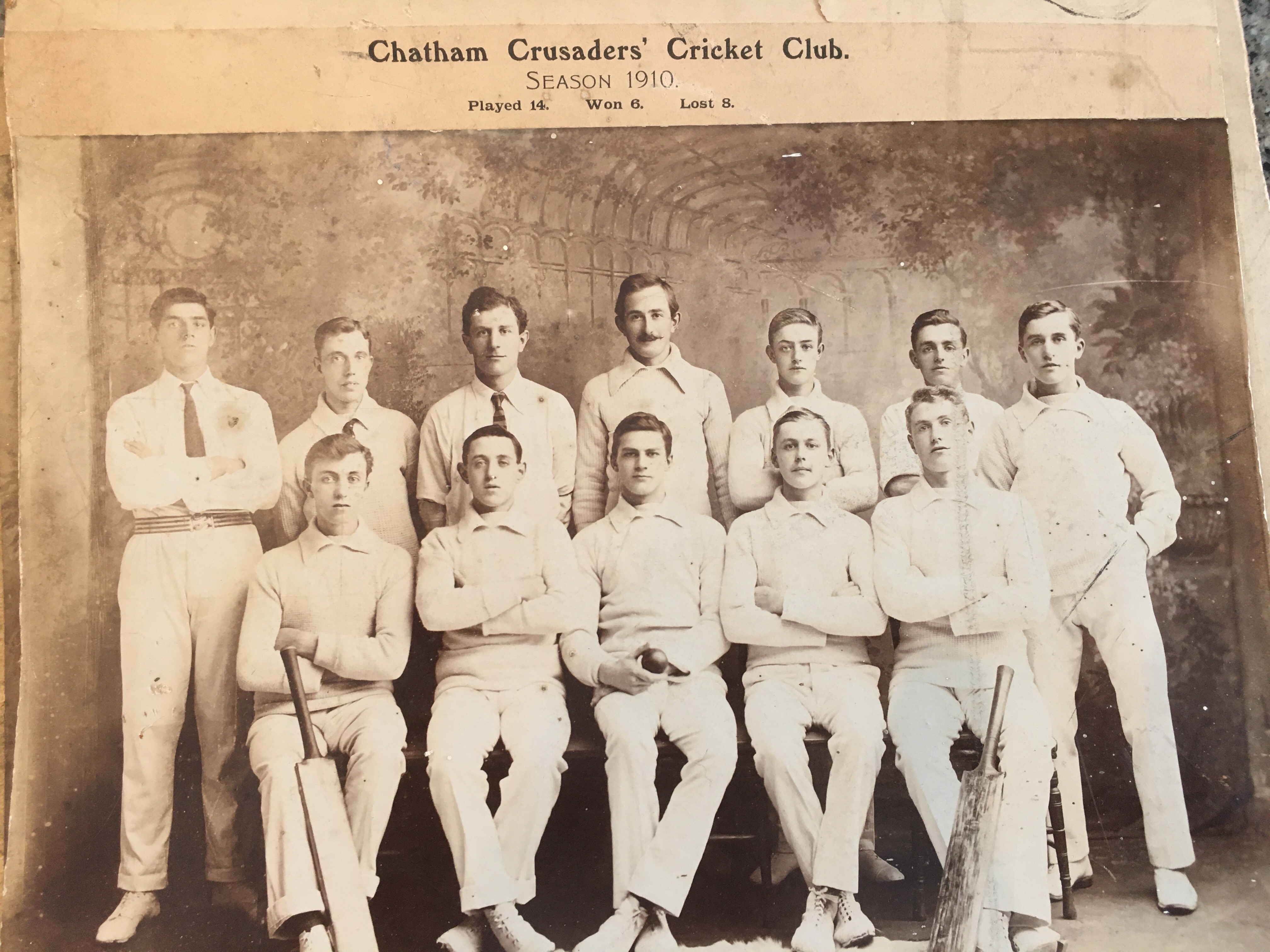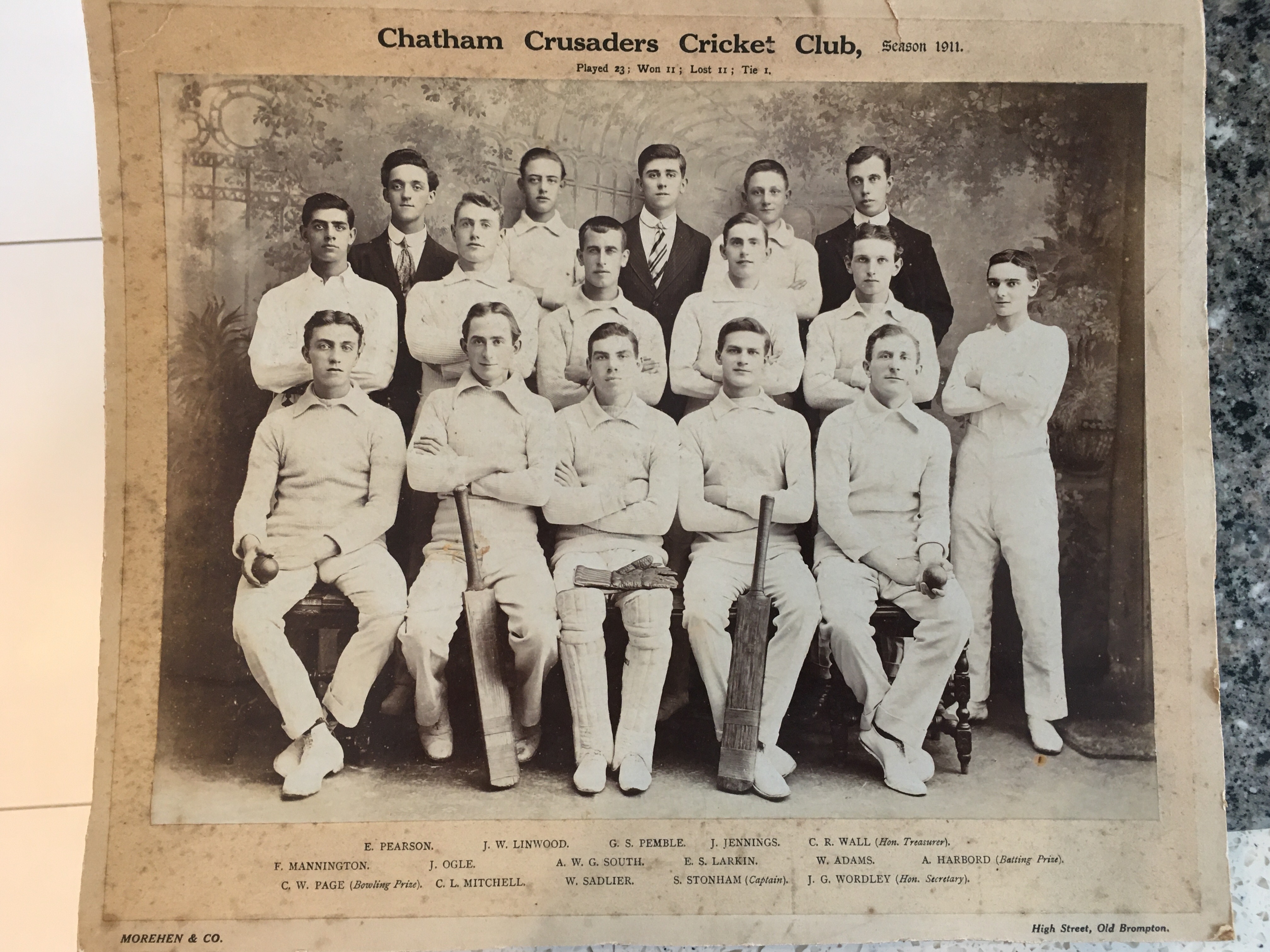The club has just been given two team photographs of Chatham Crusaders Cricket Club, dating from 1910 and 1911. The trouble is that we know very little about the club or the players, and would love to know more. The photographs were donated by a lady who sold her parents’ house in Chatham after they died, and while clearing the house found the two photographs in the attic. Neither she nor her parents had any connection with this cricket club or any of the players so we have very little information to go on. What we do know is that there is no Chatham Crusaders CC active today, although a Crusaders club based in the Medway towns was apparently in existence until the 1980s. We wondered whether there was a military connection to the club, but as none of the players have a military rank next to their name, we have to assume they were all civilians, at least until 1914. Can you help us find out a bit more about them?

What we do know is that The Crusader [singular] Cricket Club appears in the directory of club sides until 1991. They played at the Civil Services Ground and Langton Playing Field. These are in Gillingham which could explain the dropping of ‘Chatham’ in the title. One of our number recalls that “this is the club that I played against many times in the 1960s and I went on tour with them in the late 1960s, when we toured Devon. I played for the Crusaders in a remarkable game at Budleigh Salterton. Crusaders only made 91 in their innings and Budleigh Salterton were sailing along at 81 for 2. We bowled them out for 90 and won the game by 1 run.” We suspect that this club is descended from the Chatham Crusaders. But what happened after 1991?
We also want to know much more about the club in 1910 and 1911. For those pedants amongst us, I can note that the name is written with an apostrophe after the word Crusaders in 1910, thus “Chatham Crusaders’ Cricket Club”, but the apostrophe disappears one year later. There are strong arguments on both sides that either version is grammatically correct.
The photograph frames also show that in 1910 they played 14 games, winning six and losing eight. In 1911 they played 23, winning 11 and losing 11, with one game tied. No dull draws in either summer! The photographs were taken by Morehen and Co, of 6, High Street, Old Brompton. This business had been operating at these premises since 1896, and until 1903 was under the name of “James Charlesworth, Photographer”. In 1903, Mr. Morehen joined the company and the business changed its name to Charlesworth and Morehen. From 1908, the elimination of poor old James Charlesworth was complete and it became simply Morehen and Co. The shop closed in 1928, but whether that was because it moved elsewhere or closed down completely, we are not sure.

The faces that stare out at us so confidently are of young men, many of whom would have been destined to fight in the Great War. Perhaps some of the names are to be found on local war memorials? Over the two photographs, there are 20 different cricketers, of whom eight appear in both photographs. None of the names are familiar to us – none of them went on to play for the county – but that does not make them any less interesting to us.
The captain was S. Stonham, seated centrally holding a cricket ball in 1910, and seated, not quite in the middle a year later, cradling a cricket bat. An all-rounder perhaps? F. Mannington (or Manington?) appears in both portraits, a dark haired, burly man with a very smart belt in 1910. C.R. Wall was promoted from Scorer in 1910 to Treasurer in 1911, and does not wear whites in either photo, so probably did not play, but merely scored and treasured. J.G. Wordley was Hon. Secretary in both seasons, and seems to be one of the older members of the side. C.L. Mitchell shaved off his moustache between 1910 and 1911 (a wise decision) and moved his parting from the left to the centre of his forehead, something which C.W. Page, winner of the Bowling Prize in 1911, also did. J.W. Linwood stands behind the man who we assume is his brother H. Linwood in 1910, but in 1911, only J.W. appears. The only other face to appear in both years is that of J. Ogle, sitting on the far right with a cricket bat in 1910, but relegated to standing in the middle row a year later. The people who appear in only one of the photographs are, in 1910, C. Gilbert, G. Clark and B. Pennicott (vice-captain in 1910 but nowhere to be seen in 1911), as well as H. Linwood; and in 1911 E. Pearson, G.S. Pemble (both wearing stiff collars and smart ties), J. Jennings, A.W.G. South, E.S. Larkin, W. Sadleir and A. Harbord. The name Harbord rings a bell – it is the family name of the Barons Suffield, two of whom, the 4th Baron and his half brother the 5th Baron, were appointed president of M.C.C. in 1836 and 1863 respectively, the only brothers to have held that office. Possibly A. Harbord, winner of the Batting Prize in 1911, when he appears to be one of the younger members of the club, is a member of that family.
We will continue to search for any more information about the club and the players, but if you know anything about the club or its history, please get in touch with us. Any information will be highly appreciated.
Hello my name is mckenzie ibingha I’m 10 years old im very interested in the cricket club please can you contact me with information on how to join my number
07546644899
Hallo McKenzie, I am afraid that Chatham Crusaders no longer exists, so I cannot give you any more information. Thanks for contacting us.